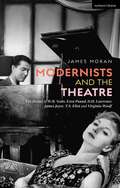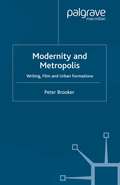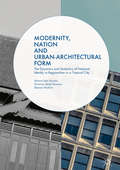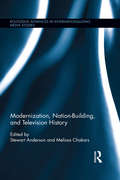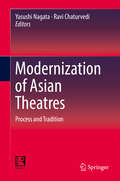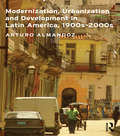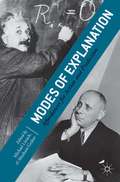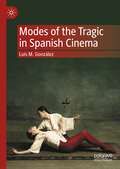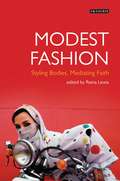- Table View
- List View
Modernist Semis and Terraces in England (Ashgate Studies in Architecture)
by Finn JensenBetween the two World Wars, there was an unprecedented need for new houses in Britain which resulted in a building boom. While only a small percentage of this building took the form of Modernism, there was still a significant number of semis and terraces built for the workers and middle-class families in the 1920s and 1930s built in this style. This book examines these modest Modernist houses within the broader context of the Modern Movement in Europe, as well as the inter-war building boom in suburban Britain. Illustrated with line drawings and photographs of more than 30 examples from around the country, and based on little-known contemporary material such as catalogues, advertisements, radio broadcasts and letters, it shows how these houses speak of a time of political, social and artistic unrest, and a world where the avant-garde architects sought to capture the spirit of modern technology in their designs for the average home owner. While the Modernist houses never became popular with the general public, the fact that so many are still standing and now sought after by twenty-first century families speak for their endurance and special appeal.
Modernists and the Theatre: The Drama of W.B. Yeats, Ezra Pound, D.H. Lawrence, James Joyce, T.S. Eliot and Virginia Woolf
by James MoranModernists and the Theatre is the first study to examine how theories of modernism intersect with those of the theatre within the works, philosophies and literary lives of six key modernist writers. Drawing on a wealth of unfamiliar archive material and fresh readings of neglected documents, James Moran reveals how these literary figures interacted with the theatre through playwriting, by engaging in philosophical debates and participating in theatrical performances. Chapters assess W.B. Yeats's very earliest playwriting, Ezra Pound's onstage acting, the interconnections between James Joyce's and D.H. Lawrence's sense of drama, Eliot's thinking about theatre in Dublin, and the feminist politics of Virginia Woolf's small-scale theatrical experiments.While these writers valued coterie production and often made hostile comments about drama, this volume highlights the paradoxical fact that, despite their harsh words, the theatrically 'large-scale' also attracted each of these writers. The theatre event of 'restricted production' offered modernists a satisfying mode of sharing their work amongst the like-minded, and the book discloses a set of unfamiliar events of this sort that allowed these writers to act as agents of legitimation in granting cultural value.The book explores their engagements with popular drama, as well as the long-forgotten acting performances in which each of these writers personally participated. Moran uncovers how the playhouse became a key geographical space where the high-modernists could explore a tension that fascinated them, and which motivated much of their wider thinking and literary work.
Modernists and the Theatre: The Drama of W.B. Yeats, Ezra Pound, D.H. Lawrence, James Joyce, T.S. Eliot and Virginia Woolf (Critical Companions Ser.)
by James MoranModernists and the Theatre is the first study to examine how theories of modernism intersect with those of the theatre within the works, philosophies and literary lives of six key modernist writers. Drawing on a wealth of unfamiliar archive material and fresh readings of neglected documents, James Moran reveals how these literary figures interacted with the theatre through playwriting, by engaging in philosophical debates and participating in theatrical performances. Chapters assess W.B. Yeats's very earliest playwriting, Ezra Pound's onstage acting, the interconnections between James Joyce's and D.H. Lawrence's sense of drama, Eliot's thinking about theatre in Dublin, and the feminist politics of Virginia Woolf's small-scale theatrical experiments.While these writers valued coterie production and often made hostile comments about drama, this volume highlights the paradoxical fact that, despite their harsh words, the theatrically 'large-scale' also attracted each of these writers. The theatre event of 'restricted production' offered modernists a satisfying mode of sharing their work amongst the like-minded, and the book discloses a set of unfamiliar events of this sort that allowed these writers to act as agents of legitimation in granting cultural value.The book explores their engagements with popular drama, as well as the long-forgotten acting performances in which each of these writers personally participated. Moran uncovers how the playhouse became a key geographical space where the high-modernists could explore a tension that fascinated them, and which motivated much of their wider thinking and literary work.
Modernity and Metropolis: Writing, Film and Urban Formations
by P. BrookerA study of urban identity and community looks at selected twentieth century literary and film texts in the context of theorizations of modernism, postmodernism, postcoloniality and globalization. Brooker draws on Beck and Giddens to propose a 'reflexive modernism' which rewrites and re-imagines the urban scene. The principal cities considered are London and New York, Tokyo, Hong Kong and Bangkok. Writers considered include Ezra Pound and T.S. Eliot, Langston Hughes, Hanif Kureishi, Iain Sinclair, Paul Auster, Sarah Schulman and William Gibson. Filmmakers include Patrick Keiller and Wong Kar-Wai.
Modernity, History, and Politics in Czech Art (Routledge Research in Art and Politics)
by Marta FilipováThis book traces the influence of the changing political environment on Czech art, criticism, history, and theory between 1895 and 1939, looking beyond the avant-garde to the peripheries of modern art. The period is marked by radical political changes, the formation of national and regional identities, and the rise of modernism in Central Europe – specifically, the collapse of Austria-Hungary and the creation of the new democratic state of Czechoslovakia. Marta Filipová studies the way in which narratives of modern art were formed in a constant negotiation and dialogue between an effort to be international and a desire to remain authentically local.
Modernity, History, and Politics in Czech Art (Routledge Research in Art and Politics)
by Marta FilipováThis book traces the influence of the changing political environment on Czech art, criticism, history, and theory between 1895 and 1939, looking beyond the avant-garde to the peripheries of modern art. The period is marked by radical political changes, the formation of national and regional identities, and the rise of modernism in Central Europe – specifically, the collapse of Austria-Hungary and the creation of the new democratic state of Czechoslovakia. Marta Filipová studies the way in which narratives of modern art were formed in a constant negotiation and dialogue between an effort to be international and a desire to remain authentically local.
Modernity, Nation and Urban-Architectural Form: The Dynamics and Dialectics of National Identity vs Regionalism in a Tropical City
by Shireen Jahn Kassim Norwina Mohd Nawawi Mansor IbrahimThis book explores how Malaysia, as a multicultural modern nation, has approached issues of nationalism and regionalism in terms of physical expression of the built environment. Ever since the nation’s post-Colonial era, architects and policy makers have grappled with the theoretical and practical outcomes of creating public architecture that effectively responds to traditions, nationhood and modernity. The authors compile and analyse prevailing ideas and strategies, present case studies in architectural language and form, and introduce the reader to tensions arising between a nationalist agenda and local ‘regionalist’ architectural language. These dichotomies represent the very nature of multicultural societies and issues with identity; a challenge that various nations across the globe face in a changing environment. This topical and pertinent volume will appeal to students and scholars of urban planning, architecture and the modern city.
Modernity, Nation and Urban-Architectural Form: The Dynamics and Dialectics of National Identity vs Regionalism in a Tropical City
by Shireen Jahn Kassim Norwina Mohd Nawawi Mansor IbrahimThis book explores how Malaysia, as a multicultural modern nation, has approached issues of nationalism and regionalism in terms of physical expression of the built environment. Ever since the nation’s post-Colonial era, architects and policy makers have grappled with the theoretical and practical outcomes of creating public architecture that effectively responds to traditions, nationhood and modernity. The authors compile and analyse prevailing ideas and strategies, present case studies in architectural language and form, and introduce the reader to tensions arising between a nationalist agenda and local ‘regionalist’ architectural language. These dichotomies represent the very nature of multicultural societies and issues with identity; a challenge that various nations across the globe face in a changing environment. This topical and pertinent volume will appeal to students and scholars of urban planning, architecture and the modern city.
Modernity without a Project: Essay on the Void Called Contemporary
by C.B. JohnsonEntering the 21st century, the postmodern succession has given way to a doom-laden, apolitical orthodoxy. This book offers suggestive readings of “the contemporary” in light of high modernity, postwar modernity, and postmodernity, as framed by the influential institutions of modern art and the spectacles of millennial architecture. Modernity without a Project critiques and connects historical avant-garde currents as they are institutionally expressed or captured, and scrutinizes the remake of New York’s Museum of Modern Art, Minoru Yamasaki’s vanished Utopias, the “anarchitecture” of Lebbeus Woods, recent work of Rem Koolhaas, delirious developments in Dubai, and the unexpected contribution to architectural debate by the late Hugo Chavez
Modernization, Nation-Building, and Television History (Routledge Advances in Internationalizing Media Studies)
by Stewart Anderson Melissa ChakarsThis innovative collection investigates the ways in which television programs around the world have highlighted modernization and encouraged nation-building. It is an attempt to catalogue and better understand the contours of this phenomenon, which took place as television developed and expanded in different parts of the world between the 1950s and the 1990s. From popular science and adult education shows to news magazines and television plays, few themes so thoroughly penetrated the small screen for so many years as modernization, with television producers and state authorities using television programs to bolster modernization efforts. Contributors analyze the hallmarks of these media efforts: nation-building, consumerism and consumer culture, the education and integration of citizens, and the glorification of the nation’s technological achievements.
Modernization, Nation-Building, and Television History (Routledge Advances in Internationalizing Media Studies)
by Stewart Anderson Melissa ChakarsThis innovative collection investigates the ways in which television programs around the world have highlighted modernization and encouraged nation-building. It is an attempt to catalogue and better understand the contours of this phenomenon, which took place as television developed and expanded in different parts of the world between the 1950s and the 1990s. From popular science and adult education shows to news magazines and television plays, few themes so thoroughly penetrated the small screen for so many years as modernization, with television producers and state authorities using television programs to bolster modernization efforts. Contributors analyze the hallmarks of these media efforts: nation-building, consumerism and consumer culture, the education and integration of citizens, and the glorification of the nation’s technological achievements.
Modernization of Asian Theatres: Process and Tradition
by Yasushi Nagata Ravi ChaturvediThis volume focuses on the theatre history of Asian countries, and discusses the specific context of theatre modernization in Asia. While Asian theatre is one of the primary interests within theatre scholarship in the world today, knowledge of Asian theatre history is very limited and often surprisingly incorrect. Therefore, this volume addresses a major gap in contemporary theatre studies. The volume discusses the conflict between tradition and modernity in theatre, suggesting that the problems of modernity are closely related to the idea of tradition. Although Asian countries preserved the traditional form and values of their respective theatres, they had to also confront the newly introduced values or mechanisms of European modernity. Several papers in this volume therefore provide critical surveys of the history of theatre modernization in Asian countries or regions—Japan, Korea, Taiwan, Hong Kong, India Malaysia, Singapore, and Uyghur. Other papers focus on specific case studies of the history of modernization, discussing contemporary Taiwanese performances, translations of modern French comedy into Chinese, the modernization of Chinese Xiqu, modern Okinawan plays, Malaysian traditional performances, Korean national theatre, and Japanese plays during World War II. Renowned academics and theatre critics have contributed to this volume, making it a valuable resource for researchers and students of theatre studies, literature, and cultural studies.
Modernization of Korean Theatre in the 20th Century (ISSN)
by Meewon LeeLee provides a comprehensive guide that traces the transformation of Korean theatre from traditional to modern theatre and examines the impact of the introduction of Western plays to Korean society.Important changes in Korean theatre are discussed chronologically from the beginning of the modernization: Sinpa Theatre, Singeuk Theatre, Theatre of Ideology, The Little Theatre Movement, Madanggeuk, experiments for modernizing traditional Korean theatrical arts, and transitions to postmodern theatre. These changes happened rapidly and coupled with Eurocentric globalization. By the end of the century, the reinterpretations of Western drama like Shakespeare's plays had reached a point where they received attention from the Western world. Today, Korean theatre keeps pace with the world theatre and strives to contribute as a member of it.This book is a vital resource for scholars and students pursuing Korean studies and East Asian theatres with an authentic Korean perspective from a Korean scholar who has lived and researched in Korea.
Modernization of Korean Theatre in the 20th Century (ISSN)
by Meewon LeeLee provides a comprehensive guide that traces the transformation of Korean theatre from traditional to modern theatre and examines the impact of the introduction of Western plays to Korean society.Important changes in Korean theatre are discussed chronologically from the beginning of the modernization: Sinpa Theatre, Singeuk Theatre, Theatre of Ideology, The Little Theatre Movement, Madanggeuk, experiments for modernizing traditional Korean theatrical arts, and transitions to postmodern theatre. These changes happened rapidly and coupled with Eurocentric globalization. By the end of the century, the reinterpretations of Western drama like Shakespeare's plays had reached a point where they received attention from the Western world. Today, Korean theatre keeps pace with the world theatre and strives to contribute as a member of it.This book is a vital resource for scholars and students pursuing Korean studies and East Asian theatres with an authentic Korean perspective from a Korean scholar who has lived and researched in Korea.
Modernization, Urbanization and Development in Latin America, 1900s - 2000s (Planning, History and Environment Series)
by Arturo AlmandozIn this book Arturo Almandoz places the major episodes of Latin America’s twentieth and early twenty-first century urban history within the changing relationship between industrialization and urbanization, modernization and development. This relationship began in the early twentieth century, when industrialization and urbanization became significant in the region, and ends at the beginning of the twenty-first century, when new tensions between liberal globalization and populist nationalism challenge development in the subcontinent, much of which is still poverty stricken. Latin America’s twentieth-century modernization and development are closely related to nineteenth-century ideals of progress and civilization, and for this reason Almandoz opens with a brief review of that legacy for the different countries that are the focus of his book – Mexico, Chile, Brazil, Argentina and Venezuela – but with references to others. He then explores the regional distortions, which resulted from the interaction between industrialization and urbanization, and how the imbalance between urbanization and the productive system helps to explain why ‘take-off’ was not followed by the ‘drive to maturity’ in Latin American countries. He suggests that the close yet troublesome relationship with the United States, the recurrence of dictatorships and autocratic regimes, and Marxist influences in many domains, are all factors that explain Latin America’s stagnation and underdevelopment up to the so-called ‘lost decade’ of 1980s. He shows how Latin America’s fate changed in the late twentieth and early twenty-first century, when neoliberal programmes, political compromise and constitutional reform dismantled the traditional model of the corporate state and centralized planning. He reveals how economic growth and social improvements have been attained by politically left-wing yet economically open-market countries while others have resumed populism and state intervention. All these trends make up the complex scenario for the new century – especially when considered against the background of vibrant metropolises that are the main actors in the book.
Modernization, Urbanization and Development in Latin America, 1900s - 2000s (Planning, History and Environment Series)
by Arturo AlmandozIn this book Arturo Almandoz places the major episodes of Latin America’s twentieth and early twenty-first century urban history within the changing relationship between industrialization and urbanization, modernization and development. This relationship began in the early twentieth century, when industrialization and urbanization became significant in the region, and ends at the beginning of the twenty-first century, when new tensions between liberal globalization and populist nationalism challenge development in the subcontinent, much of which is still poverty stricken. Latin America’s twentieth-century modernization and development are closely related to nineteenth-century ideals of progress and civilization, and for this reason Almandoz opens with a brief review of that legacy for the different countries that are the focus of his book – Mexico, Chile, Brazil, Argentina and Venezuela – but with references to others. He then explores the regional distortions, which resulted from the interaction between industrialization and urbanization, and how the imbalance between urbanization and the productive system helps to explain why ‘take-off’ was not followed by the ‘drive to maturity’ in Latin American countries. He suggests that the close yet troublesome relationship with the United States, the recurrence of dictatorships and autocratic regimes, and Marxist influences in many domains, are all factors that explain Latin America’s stagnation and underdevelopment up to the so-called ‘lost decade’ of 1980s. He shows how Latin America’s fate changed in the late twentieth and early twenty-first century, when neoliberal programmes, political compromise and constitutional reform dismantled the traditional model of the corporate state and centralized planning. He reveals how economic growth and social improvements have been attained by politically left-wing yet economically open-market countries while others have resumed populism and state intervention. All these trends make up the complex scenario for the new century – especially when considered against the background of vibrant metropolises that are the main actors in the book.
Modernizing Main Street: Architecture and Consumer Culture in the New Deal (Center for American Places - Center Books on American Places)
by Gabrielle EsperdyAn important part of the New Deal, the Modernization Credit Plan helped transform urban business districts and small-town commercial strips across 1930s America, but it has since been almost completely forgotten. In Modernizing Main Street, Gabrielle Esperdy uncovers the cultural history of the hundreds of thousands of modernized storefronts that resulted from the little-known federal provision that made billions of dollars available to shop owners who wanted to update their facades. Esperdy argues that these updated storefronts served a range of complex purposes, such as stimulating public consumption, extending the New Deal’s influence, reviving a stagnant construction industry, and introducing European modernist design to the everyday landscape. She goes on to show that these diverse roles are inseparable, woven together not only by the crisis of the Depression, but also by the pressures of bourgeoning consumerism. As the decade’s two major cultural forces, Esperdy concludes, consumerism and the Depression transformed the storefront from a seemingly insignificant element of the built environment into a potent site for the physical and rhetorical staging of recovery and progress.
Modernizing Main Street: Architecture and Consumer Culture in the New Deal (Center for American Places - Center Books on American Places)
by Gabrielle EsperdyAn important part of the New Deal, the Modernization Credit Plan helped transform urban business districts and small-town commercial strips across 1930s America, but it has since been almost completely forgotten. In Modernizing Main Street, Gabrielle Esperdy uncovers the cultural history of the hundreds of thousands of modernized storefronts that resulted from the little-known federal provision that made billions of dollars available to shop owners who wanted to update their facades. Esperdy argues that these updated storefronts served a range of complex purposes, such as stimulating public consumption, extending the New Deal’s influence, reviving a stagnant construction industry, and introducing European modernist design to the everyday landscape. She goes on to show that these diverse roles are inseparable, woven together not only by the crisis of the Depression, but also by the pressures of bourgeoning consumerism. As the decade’s two major cultural forces, Esperdy concludes, consumerism and the Depression transformed the storefront from a seemingly insignificant element of the built environment into a potent site for the physical and rhetorical staging of recovery and progress.
Moderns Abroad: Architecture, Cities and Italian Imperialism (Architext)
by Mia FullerThis volume studies the architecture and urbanism of modern-era Italian colonialism (1869-1943) as it sought to build colonies in North and East Africa and the eastern Mediterranean. Mia Fuller follows, not only the design of the physical architecture, but also the development of colonial design theory, based on the assumptions made about the colonized, and also the application of modernist theory to both Italian architecture and that of its colonies. Moderns Abroad is the first book to present an overview of Italian colonial architecture and city planning. In chronicling Italian architects' attempts to define a distinctly Italian colonial architecture that would set Italy apart from Britain and France, it provides a uniquely comparative study of Italian colonialism and architecture that will be of interest to specialists in modern architecture, colonial studies, and Italian studies alike.
Moderns Abroad: Architecture, Cities and Italian Imperialism (Architext)
by Mia FullerThis volume studies the architecture and urbanism of modern-era Italian colonialism (1869-1943) as it sought to build colonies in North and East Africa and the eastern Mediterranean. Mia Fuller follows, not only the design of the physical architecture, but also the development of colonial design theory, based on the assumptions made about the colonized, and also the application of modernist theory to both Italian architecture and that of its colonies. Moderns Abroad is the first book to present an overview of Italian colonial architecture and city planning. In chronicling Italian architects' attempts to define a distinctly Italian colonial architecture that would set Italy apart from Britain and France, it provides a uniquely comparative study of Italian colonialism and architecture that will be of interest to specialists in modern architecture, colonial studies, and Italian studies alike.
Modes of Explanation: Affordances for Action and Prediction
by Michael Lissack Abraham GraberModes of Explanation is the first book in decades to attempt to bring these conflicting approaches together and to offer a compelling narrative to explore how the paradox of 'explanation' can converge.
Modes of the Tragic in Spanish Cinema
by Luis M. GonzálezThis book focuses on expressions of the tragic in Spanish cinema. Its main premise is that elements from the classical and modern tragic tradition persist and permeate many of the cultural works created in Spain, especially the films on which the book centers this study. The inscrutability and indolence of the gods, the mutability of fortune, the recurrent narratives of fall and redemption, the unavoidable clash between ethical forces, the tension between free will and fate, the violent resolution of both internal and external conflicts, and the overwhelming feelings of guilt that haunt the tragic heroine/hero are consistent aspects that traverse Spanish cinema as a response to universal queries about human suffering and death.
Modest Fashion: Styling Bodies, Mediating Faith (Dress Cultures)
by Reina LewisModest dressing, both secular and religious, is a growing trend across the world, yet so far it has been given little serious attention and is rarely seen as fashion. Modest Fashion uniquely studies and addresses both the consumers and the producers of modest clothing. It examines the growing number of women who, for reasons of religion, faith or personal preference, decide to cover their bodies and dress in a way that satisfies their spiritual and stylistic requirements. These are women who are making fashionable the art of dressing modestly. Scholars and journalists, fashion designers and bloggers explore the emergence of a niche market for modest fashion and examine how this operates across and between faiths, and in relation to 'secular' dressers.
Modest_Witness@Second_Millennium. FemaleMan_Meets_OncoMouse: Feminism and Technoscience
by Donna J. Haraway Thyrza GoodeveOne of the founders of the posthumanities, Donna J. Haraway is professor in the History of Consciousness program at the University of California, Santa Cruz. Author of many books and widely read essays, including the now-classic essay "The Cyborg Manifesto," she received the J.D. Bernal Prize in 2000, a lifetime achievement award from the Society for Social Studies in Science. Thyrza Nicholas Goodeve is a professor of Art History at the School of Visual Arts.
Modest_Witness@Second_Millennium. FemaleMan_Meets_OncoMouse: Feminism and Technoscience
by Donna J. Haraway Thyrza GoodeveOne of the founders of the posthumanities, Donna J. Haraway is professor in the History of Consciousness program at the University of California, Santa Cruz. Author of many books and widely read essays, including the now-classic essay "The Cyborg Manifesto," she received the J.D. Bernal Prize in 2000, a lifetime achievement award from the Society for Social Studies in Science. Thyrza Nicholas Goodeve is a professor of Art History at the School of Visual Arts.

